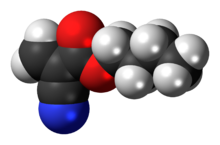
| |

| |
| Names | |
|---|---|
| Preferred IUPAC name
Butyl 2-cyanoprop-2-enoate | |
| Other names
Butyl 2-cyanopropenoate
Butyl 2-cyanoacrylate 2-Cyano-2-propenoic acid n-butyl ester n-Butyl 2-cyanoacrylate n-BCA NBCA n-Butyl alpha-cyanoacrylate Enbucrilate (INN) | |
| Identifiers | |
3D model (JSmol)
|
|
| ChEMBL | |
| ChemSpider | |
| ECHA InfoCard | 100.026.866 |
| EC Number |
|
PubChem CID
|
|
| UNII | |
CompTox Dashboard (EPA)
|
|
| |
| |
| Properties | |
| C8H11NO2 | |
| Molar mass | 153.181 g·mol−1 |
| Density | 0.986 g/cm3 at 20 °C[1] |
| Boiling point | 69–72 °C (156–162 °F; 342–345 K)[1] at 1.6 mmHg |
| Hazards | |
| Flash point | > 80 °C (176 °F; 353 K) |
Except where otherwise noted, data are given for materials in their standard state (at 25 °C [77 °F], 100 kPa).
| |
n-Butyl cyanoacrylate (n-BCA, NBCA), a cyanoacrylate ester, is a butyl ester of 2-cyano-2-propenoic acid. It is a colorless liquid with a sharp, irritating odor. It is insoluble in water. Its chief use is as the main component of medical cyanoacrylate glues.[2] It can be encountered under various trade names, e.g. Cutseal, MediBond, MediCryl, PeriAcryl, GluStitch, Xoin, Gesika, VetGlu, Vetbond, LiquiVet, Indermil, LiquiBand, Histoacryl, IFABond, CutisSeal and others.[3] The generic international nonproprietary name (INN) for NBCA is enbucrilate.
In medical and veterinary applications, NBCA, isobutyl cyanoacrylate, and octyl cyanoacrylate are commonly used. They are bacteriostatic and their use is usually painless. Butyl esters provide stronger bond, but are rigid. Octyl esters, while providing weaker bond, are more flexible. Blends of octyl cyanoacrylate and n-butyl cyanoacrylate are available (such as GLUture) which offer both flexibility and a strong bond. n-Butyl cyanoacrylate is also used for embolization of cerebral arteriovenous malformations before their surgical treatment.[2]
NBCA in monomer form is soluble in acetone, methyl ethyl ketone, nitromethane, and methylene chloride.[4] It polymerizes rapidly in presence of ionic substances such as moisture, blood, or tissue fluids.
NBCA has unique properties compared to other cyanoacrylates such as octyl cyanoacrylate or isoamyl cyanoacrylate. The polymerized form has excellent tensile strength and is very effective in closing surgical or wound incisions.
The closure of the wound or cut is quick (about 30 to 45 seconds) and the product has inherently some valuable bacteriostatic properties. The cosmetic outcome of the closure is comparable or generally better than an equivalent suture substitute with least amount of scarring visible after three to six months.[citation needed]
Also important is the degradation properties of polymerized NBCA within the body. This property of NBCA has made it a very useful polymer to create various nanoparticles for delivery of drugs into the body with sustained release profiles.
Heating to higher temperatures causes pyrolysis and depolymerization of the cured glue, producing gaseous products strongly irritating to lungs and eyes.
- ^ a b "Butyl cyanoacrylate". CAS Common Chemistry. American Chemical Society.
- ^ a b "n-Butyl-2-cyanoacrylate". Chemical Sampling Information. Washington, DC, USA: Occupational Safety & Health Administration. 17 January 2007. Retrieved 25 June 2011.
- ^ "Material Safety Data Sheet for Butyl Octyl Blend" (PDF). GluStitch Inc. 19 October 2009. Archived from the original (PDF) on 26 March 2012. Retrieved 25 June 2011.
- ^ "Cyanoacrylate Technical Data". Archived from the original on 2008-12-08. Retrieved 2008-12-17.